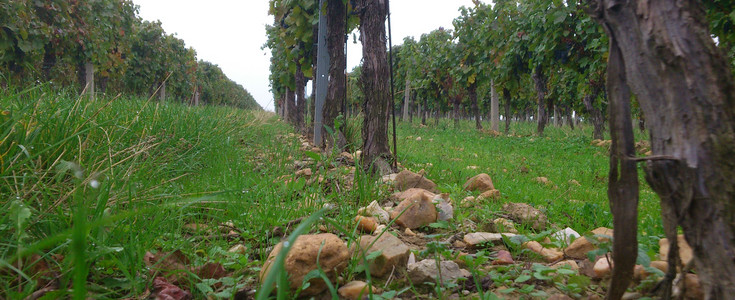Research

Fundamental and applied research performed with innovative techniques target today’s topics such as grapevine physiology of under climate change stresses (biotic and abiotic), fruit physiology and quality, fruit grapevine breeding, organic viticulture and fruit growing as well as precision viticulture.
In close cooperation with producers our researchers pursue the goal of sustainably securing and improving high-quality wine and fruit production.
Latest SCI publications
Latest Projects
Research project (§ 26 & § 27)
Duration
: 2025-05-01 - 2028-04-30
Berry Shrivel (BS, Traubenwelke) is a sugar accumulation disorder of grapevine of unknown causes, having a great negative impact on grape quality and incalculable risks for yield losses, and for which no reliable curative practices are available. The Austrian autochthonous red wine cultivar Blauer Zweigelt is heavily affected by BS, although the appearance of BS symptoms as well as their intensity can change from year to year making it unpredictable and hard to quantify. This has led to winegrowers avoiding planting Blauer Zweigelt with a consequent loss of typicity for the Austrian wine landscape. Therefore, the BAISIQ project aims to develop a reliable and standardized method to estimate BS occurrence in vineyards, and as a consequence yield loss. To do so, the BAISIQ partnership includes experts in the fields of grapevine biology working on BS, explainable artificial intelligence (AI), and Image-based yield Quantification on the proximal and remote scale. The interdisciplinary group of plant physiologists, computer scientist and technicians will apply multi-sensor technologies, machine learning algorithms and remote sensing equipment to achieve both, scientific and applied aims of BAISIQ. Ultimately, we aim to quantify BS in vineyards, to develop a service or a usable application, and to start establishing a BS database. Thereby we will adapt and further establish current grape cluster recognition machine learning methods and translate this knowledge into a high-throughput remote sensing application. A pre-symptomatic BS diagnostic would be of major relevance and highly innovative, and the knowledge on the expected yield loss would empower winegrowers to adapt their harvesting dates, cellar capacities and targeted wine styles. Furthermore, the innovative and pioneering approach developed in BAISIQ combining multi-sensor phenotyping and machine learning AI could be applied to other relevant features in viticulture.
Research project (§ 26 & § 27)
Duration
: 2024-12-01 - 2027-11-30
Physiological ripening disorders of grapevine affect yield and berry quality substantially every year. Although physiological ripening disorders are of high economic importance in viticulture, the information are scarce and causes still need to be identified. Therefore, further attention is needed to understand the induction of the ripening disorder berry shrivel including the influence of environmental factors, which has not been studied so far.
The project aims to identify potential underlying environmental factors influencing BS abundance in vineyards in order to develop BS risk factors on a local spatial scale with in multi-disciplinary approach. Thereby we follow the hypothesis that a) environmental factors could summarize to a higher probability of BS incidence, b) that we can scale, translate and extrapolate these factors on GIS maps and c) that wine making itself allows a certain percentage of BS grapes included without negative effects on aroma profiles.
Our experimental approach can be summarized in three work packages (WPs): 1) Developing a BS monitoring method and bring this information into a BS abundance map linked with spatial (geology, soil and vineyard management) and temporal (microclimate, climate) information. 2) We are going to investigate the consequences of BS on aroma profiles of berries and processed wines in order to provide recommendations for farmers, and targeted metabolites will be determined on a phenological timescale in order to follow BS development. 3) Finally, we aim to extract BS risk factors on a spatial and temporal scale for vineyards of our study region, and additionally process the obtained information to drought risk maps. Methods used will be: GIS mapping, climate models, soil analyses, geological characterization, vine physiology, targeted metabolites and aroma metabolites.
Our approach will close a gap of knowledge on the physiological ripening disorder berry shrivel by establishing the frist time a spatial information of BS within a study region involving a set of important influencing factors relevant for grape berry ripening. This multi-disciplinary approach is a novelty to target berry shrivel with the aim to identify inducing factors.
Research project (§ 26 & § 27)
Duration
: 2024-01-03 - 2025-01-02
Optimising water management in vineyards is of great importance for sustainability. As a finite resource, fresh water use for irrigation must be used only when strictly necessary and in the right amounts. Currently, irrigation volumes in vineyards are calculated over the basis of theoretical water consumption estimations performed using only climatic parameters (e.g. calculating fractions of the reference evapotranspiration). Very often the actual plant water status is neglected, mainly because the difficulties of performing reliable measurements in a representative way for a vineyard. Therefore, finding a good proxy for plant water status is pivotal to optimize water management in crops. Artificial intelligence approaches could represent a tool to improve our prediction capabilities. However, artificial intelligence and machine learning approaches require a large amount of data to calibrate the working algorithms. The aim of the project is to provide possible inputs regarding grapevine water use and water status in a digital and continuous way, with proper standard validation measurements, to be use in a machine learning algorithm, with the ultimate goal of training an artificial intelligence able to decide when and how much to irrigate grapevines while optimising the water resources.
